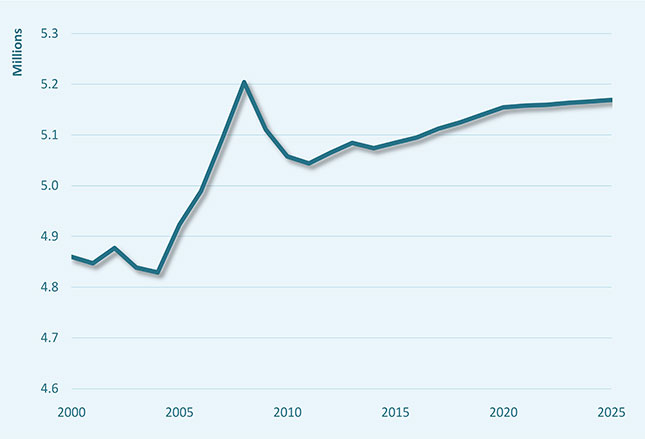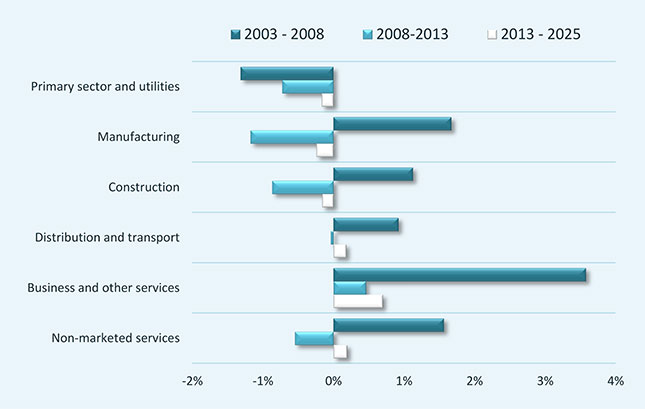
Czech Republic: Forecast highlights up to 2025
Between now and 2025
- Employment is forecast to rise steadily, but remain below its 2008 pre-crisis level.
- Most employment growth will be in business and other services.
- Most job opportunities, around 23%, will be for professionals.
- Around 34% of the labour force will have high-level qualifications, compared to 23% in 2013.
Following the economic crisis in 2008, the Czech Republic’s GDP started to recover in 2010, but then fell in 2012 and 2013. In 2013, the Czech Republic’s unemployment rate was 7%, below the European Union (EU) average of 11%. The European Commission forecasts GDP growth for the Czech Republic of 2.5% in 2015 and 2.6% in 2016.
Employment outlook
According to Cedefop’s skills supply and demand forecasts (see scenario assumptions), economic growth will have positive effects on job growth in the Czech Republic, however employment is not expected to reach its 2008 pre-crisis level by 2025 (Figure 1). This is slower than employment growth forecast for the EU as a whole, where average employment is expected to reach its pre-crisis level in 2020.

Sector developments
The economic crisis reduced employment in almost all sectors, notably in manufacturing and construction between 2008 and 2013 (Figure 2). However, employment in business and other services increased over the same period. Future employment growth in the Czech Republic up to 2025 will be in business and other services, non-marketed (largely public sector) services, and distribution and transport. The employment share of the manufacturing, construction and primary sectors is forecast to continue to fall, but at a much slower rate.
 Source: Cedefop skills forecasts (2015)
Source: Cedefop skills forecasts (2015)Occupations and qualifications prospects
Cedefop’s forecasts give insights on job opportunities between now and 2025. Total job opportunities are the sum of newly created jobs (expansion demand) and job opportunities arising because of the need to replace people who either go on to other jobs or leave the labour market, for example due to retirement (replacement demand). Often, replacement demand provides more job opportunities than expansion demand, which means that there will still be job opportunities even if the overall level of employment falls. Relatively slow job growth and an ageing labour force mean that between now and 2025 replacement demand in the Czech Republic is forecast to provide almost all job opportunities.
In the Czech Republic, most job opportunities, around 22%, will be for professionals (high level occupations in science, engineering healthcare, business and teaching), followed by around 17% for technicians and associate professionals (occupations applying scientific or artistic concepts, operational methods and regulations in engineering, healthcare, business and the public sector) (Figure 3). Job opportunities forecast for clerical support workers (workers who record, organise, store, compute and retrieve information, and perform several clerical duties in connection with money-handling operations, travel arrangements, requests for information, and appointments) in the Czech Republic, around 11%, is higher than the EU average of 9% for this occupational group.
 Source: Cedefop skills forecasts (2015)
Source: Cedefop skills forecasts (2015)Most job opportunities created through expansion demand in the Czech Republic will require high-level qualifications (ISCED 97 levels 5 and 6) (Figure 4). However, because of replacement demand, overall, most job opportunities will require medium-level qualifications (ISCED 97 levels 3 and 4).
 Source: Cedefop skills forecasts (2015)
Source: Cedefop skills forecasts (2015)Labour force trends
Future labour supply trends depend mainly on demographics and the size of the working-age population (defined in the forecasts as people aged 15 and older), participation in the labour force (people in the working-age population either in or actively seeking work) and how quickly people acquire formal qualifications.
Eurostat’s latest population projection (Europop 2013) for Czech Republic reflects the current trends in fertility rates and net migration flows. The Czech Republic’s working-age population is projected to grow by around 1% between now and 2025. However, labour market participation in the Czech Republic is forecast to fall from 59% in 2013 to 58% in 2025, but still remains above the EU average forecast of 55.5%.
Following the EU demographic trend, the Czech Republic’s population is getting older (Figure 5). Between now and 2025, although numbers of people aged 15 to 19 are expected to rise, the biggest increases are projected in the age group 45 to 54. Numbers of people aged between 20 and 44 are expected to fall substantially.
 Source: Cedefop skills forecasts (2015)
Source: Cedefop skills forecasts (2015)Although older, the Czech Republic’s labour force is becoming more highly qualified (Figure 6). This is explained by older less qualified people leaving and younger more highly-educated people entering the labour market. By 2025, the share of the Czech Republic’s labour force with high-level qualifications is forecast to rise to 34% compared to 23% in 2013 and 18% in 2005. People with medium-level qualifications in 2025 will account for 60% of the labour force compared to 69.4 % in 2013. The share of the labour force with low-level or no qualifications is forecast to fall from 7.6% in 2013 to 6% in 2025.
According to Cedefop’s forecasts, by 2020 in the Czech Republic, around 42% of 30 to 34 year-olds will have high level qualifications, above the EU’s educational attainment benchmark of 40% by 2020. On current trends, around 52% of 30 to 34 year-olds in the Czech Republic will have high-level qualifications by 2025.
 Source: Cedefop skills forecasts (2015)
Source: Cedefop skills forecasts (2015)In the Czech Republic, in 2013, 5.4% of young people left the education and training system with low-level qualifications meeting its national target of less than 5.5% by 2020. In the EU, the average in 2013 was 11.9% still above its benchmark of less than 10% of young people leaving the education and training system with low-level qualifications by 2020.
Experts’ view
Cedefop’s forecasts and their assumptions are regularly discussed with national experts. Hana Zackova and Tereza Vavrinova, analysts from the National Training Fund and Filip Pertold, researcher at the Centre for Economic Research and Graduate Education, consider the forecasts’ underlying assumptions and results plausible.
They add that the Europop 2013 population projections are slightly higher than national ones. National forecasts predict the Czech Republic’s population ageing faster. These differences, however, mostly concern the population over 65 and so should have little impact on economic performance. The European Commission’s economic forecast is in line with national estimates.
There is also a slight difference in employment trends for 2008-13 for non-marketed services due to different methodologies for counting employment. Labour Force Survey data show employment in this sector as stable or growing slightly. National accounts data, used in Cedefop’s forecasts, report a small decline.
Cedefop skills supply and demand forecasts’ scenario
Cedefop skills supply and demand forecasts take account of global economic developments up to October 2014. Despite significant differences between countries, the forecasts generally assume that a modest economic recovery will slowly increase confidence in the EU, increasing investment, consumer spending and exports. Inflation stays in target range and interest rates low, while higher tax revenues help governments reduce debt.
The assumptions reflect the latest Eurostat population forecast (Europop 2013, published in spring 2014) and the short-term macroeconomic forecast produced by the European Commission in November 2014.
Cedefop’s forecasts use harmonised data and methodology for all countries covered to allow cross-country comparisons. They do not substitute national forecasts. Total employment data correspond to those reported in national accounts.
Cedefop’s latest skills demand and supply forecasts up to 2025 cover 28 EU Member States plus Iceland, Norway and Switzerland. Results are regularly updated and together with key assumptions and methodological developments are reviewed by national experts.
For the latest update and more detailed skills forecast data visit: www.cedefop.europa.eu/forecast


